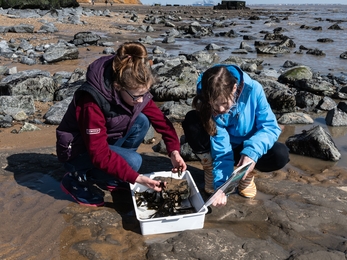Finding fossils in Essex
Megalodon tooth at The Naze Nature Discovery Centre

Volunteer Peter Dimmick holding fossils at The Naze
1) Why is Essex such a great county for fossil hunting?
In the UK, nothing can compare to the Jurassic Coast of Dorset and Devon where Mary Anning made her astounding dinosaur fossil discoveries. That said, Essex has some amazing fossil sites, the best amongst them being Walton-on-the-Naze which is a nationally important fossil location.
2) Where are the best beaches/coastal spots in the county for fossil hunting?
Coastal fossil locations are, from north to south, Wrabness, Harwich, Walton-on-the-Naze, East Mersea, Maylandsea, Steeple bay and Burnham on Crouch. One more site that I would like to include although the pits have now been filled in is Aveley where two different species of mammoth were discovered in the 1960s only a few centimetres apart but from different eras.
3) What sort of fossils are beachcombers most likely to find?
All of the sites listed above have fossils dating from 55 to 52 million years ago which come out of the London Clay. At this time, Essex was covered by 200 metres of sea with the nearest land being in the Midlands. The climate was then sub-tropical and vegetation would have been palm trees, mangroves and magnolias etc. Most fossils are, therefore, mainly marine but do also include animals and vegetation carried out to sea by river estuaries.
4) What have been some of the most exciting fossil finds along Essex’s shorelines?
Fossils include sharks and ray teeth and vertebrae, fossilised wood, bird bones, lobster, crab, shells, turtles, snakes, crocodiles and a few mammals. Walton also has the benefit of another layer called the Red Crag which is 3-2 million years old and is stuffed full of marine shells. This layer only exists in Essex and a few locations in Suffolk. I have in my collection, which is only from Walton, about 30 different species of marine fossil shell. An internationally rare shell which is found at Walton is Neptunea angulata or the left-handed whelk which is special because it spirals the opposite way to all other shells. If you find a fossil, you can visit The Naze Nature Discovery Centre where a member of staff or volunteer will help you identify it.
5) Is there a best time of year to go fossil hunting in Essex?
Nearly everyone coming to Walton will be able to find sand shark teeth, fossilised wood and Red Crag shells all year round. Much rarer are mackerel shark teeth but the fossil everyone one wants to find is a megladon tooth. Only about six of these are found every year. Because of the constant erosion of the cliffs newly exposed fossils appear all the time but you can never tell from day to day what may turn up. Essex Wildlife Trust offer guided walks and fossil hunts so you can be joined by an expert to help you discover your hidden treasure.


